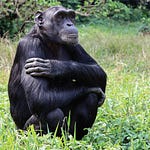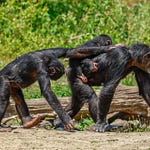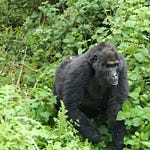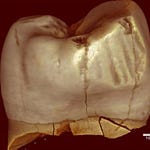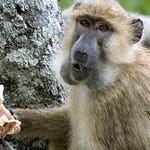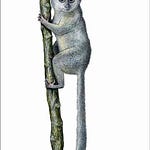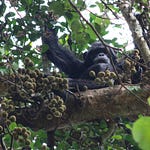“The fact that chimpanzees treat not only themselves but also others suggests a level of social awareness that is too often underestimated.”
Medicine Before Homo
In the dense canopy of Uganda’s Budongo Forest, the wounded receive care—not from doctors or shamans, but from fellow chimpanzees. The gestures are subtle but unmistakable: a leaf dabbed gently on a swollen limb, a tongue pressed to a wound, chewed bark applied with careful intent. These behaviors, documented over decades of observation, offer a rare window into the early roots of medicine—long before hospitals and Hippocrates.
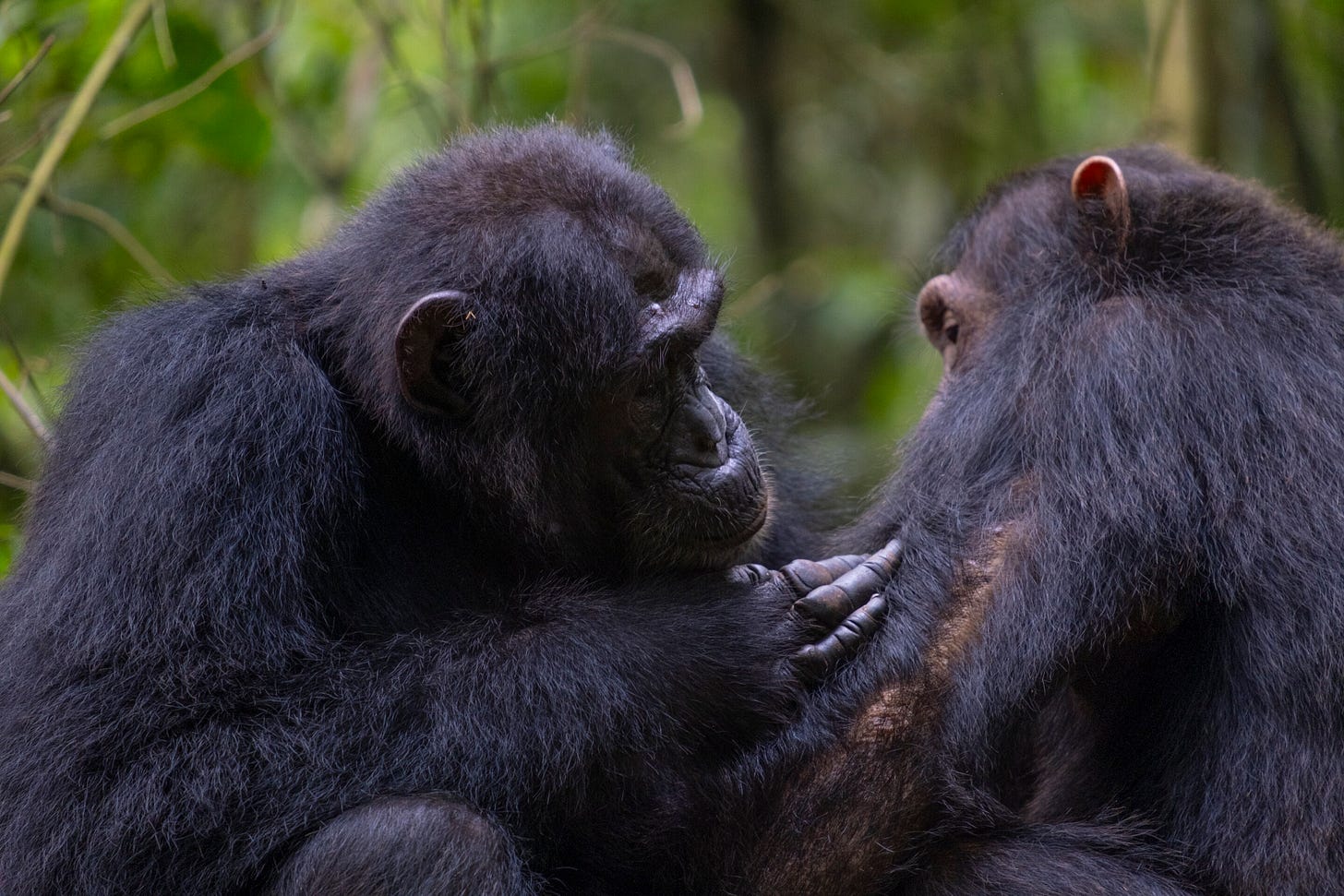
A new study by Elodie Freymann and colleagues, published in Frontiers in Ecology and Evolution1, offers the most detailed portrait yet of health-related behavior in wild chimpanzees. It captures not only the well-documented phenomenon of self-medication, but also something more profound: prosocial care, in which one individual tends to the wounds or hygiene of another. This pattern, seen in both kin and non-kin, nudges us closer to understanding when and how care became an evolutionary strategy.
The Forest as Clinic
The research focused on two chimpanzee communities in Budongo: Sonso, long habituated and closely observed since the 1990s, and Waibira, a more recently monitored group. Over four months of targeted fieldwork and 30 years of archived records, researchers recorded 41 healthcare-related events, ranging from wound licking and leaf-dabbing to the application of chewed plant matter. These acts weren't random.
“Chimpanzee wound care encompasses several techniques: direct wound licking, finger licking followed by wound pressing, leaf-dabbing, and chewing plant materials and applying them directly to wounds,” notes Freymann.
More than half of these acts involved the use of plants, many of which have recognized medicinal properties. One individual was observed chewing the bark of Argomuellera macrophylla, then applying the mixture to a gash on his leg. Others used leaves from Alchornea floribunda, Acalypha species, or Pseudospondias microcarpa—plants that traditional healers also use for treating infection, inflammation, and wounds.
Care for the Collective
Perhaps most striking were the recorded instances of prosocial care: chimpanzees tending to others, even when there was no clear genetic gain. Out of the seven prosocial care cases observed, four involved wound treatment, two involved snare removal, and one involved post-coital hygiene. Care was given by males and females alike, and recipients were often unrelated to their caregivers.
In one instance, a chimpanzee named NT carefully applied a chewed leaf to a wound on her mother’s vulva after a violent confrontation, mimicking her mother's earlier self-care. In another, a male named PS licked a deep wound on his male companion's leg. A female, NR, was seen wiping a male’s genitals with leaves after mating.
“These behaviors add to the evidence that chimpanzees recognize suffering in others and act to alleviate it, even when there's no obvious personal benefit,” Freymann explained.
Such behaviors challenge long-held assumptions that healthcare in non-human animals is driven solely by kinship or self-interest. Instead, they suggest something deeper: a shared recognition of vulnerability, and a social impulse to respond.
The Pharmacology of Instinct
The plants used in these care episodes weren’t chosen at random. Many are known in human ethnomedicine for their antibacterial, antifungal, or analgesic properties. Alchornea floribunda, for instance, is used in Central Africa for treating wounds, infections, and skin disorders. Senna spectabilis—used in genital cleaning—has known antimicrobial qualities. The chimpanzees, it seems, aren’t just experimenting. They’re selecting tools with purpose.

Some researchers classify these behaviors as zoopharmacognosy—the non-human animal use of biologically active substances to treat disease. But what makes the Budongo findings stand out is their social dimension. It’s one thing for an individual to treat itself. It’s quite another to help another.
Evolutionary Echoes
The implications of this study extend beyond chimpanzees. They force a reevaluation of the origins of medicine. If our closest living relatives can identify illness, apply treatments, and render aid to others, then the roots of human medicine may lie deeper in the primate lineage than previously assumed.
Christine Webb, a primatologist not involved in the research, put it succinctly:
“Concern for other apes’ well-being offers evidence that some of the foundations of human medicine—recognizing suffering, applying treatments and caring for others—are not uniquely human, but part of our deep evolutionary heritage.”
These behaviors may also shed light on the emergence of empathy, cooperation, and moral reasoning. In the complex social world of chimpanzees, the act of helping may foster alliances, ease tensions, or build reputation. But sometimes, as in the case of the male who freed an unrelated female from a deadly snare, it may simply be the right thing to do.
Why It Matters
The Budongo study doesn't pretend to be definitive. The authors note that rare behaviors like prosocial care are difficult to observe consistently and are influenced by many variables—from social hierarchy to observation time. Yet the patterns are compelling. Where once only humans were thought to bandage, treat, and console, chimpanzees now stand as fellow practitioners of care.
In a world increasingly defined by empathy’s boundaries—who deserves care, who gets left behind—these forest scenes remind us that the origins of medicine were likely not sterile, institutional, or even strictly human. They were improvised acts of compassion among creatures who saw pain in each other, and responded.
Related Research
Mascaro, M., et al. (2022). Application of insects to wounds in wild chimpanzees. Current Biology, 32(5), 1074–1080. https://doi.org/10.1016/j.cub.2022.01.045
Clark, F. E., et al. (2021). Wound care in wild chimpanzees: The possible role of plant-based self-medication. Scientific Reports, 11(1), 4099. https://doi.org/10.1038/s41598-021-83794-0
Laumer, I. B., et al. (2024). A wild orangutan applies a medicinal plant to a wound. Scientific Reports, 14, 1329. https://doi.org/10.1038/s41598-024-52437-7
Kessler, S. E., & Aunger, R. (2022). A framework for the study of non-human healthcare systems. Evolutionary Anthropology, 31(2), 77–88. https://doi.org/10.1002/evan.21937
Freymann, E., Hobaiter, C., Huffman, M. A., Klein, H., Muhumuza, G., Reynolds, V., Slania, N. E., Soldati, A., Yikii, E. R., Zuberbühler, K., & Carvalho, S. (2025). Self-directed and prosocial wound care, snare removal, and hygiene behaviors amongst the Budongo chimpanzees. Frontiers in Ecology and Evolution, 13, 1540922. https://doi.org/10.3389/fevo.2025.1540922



